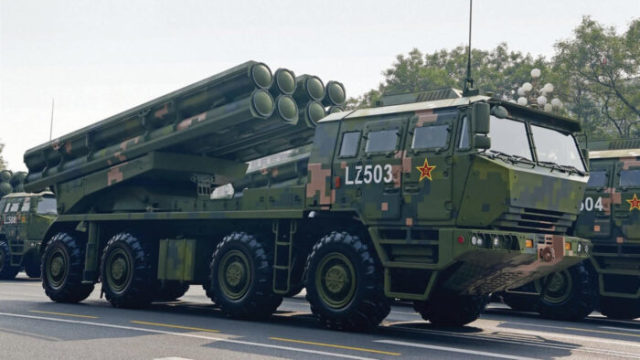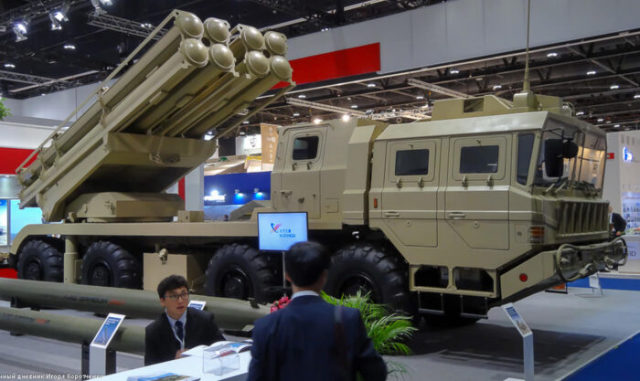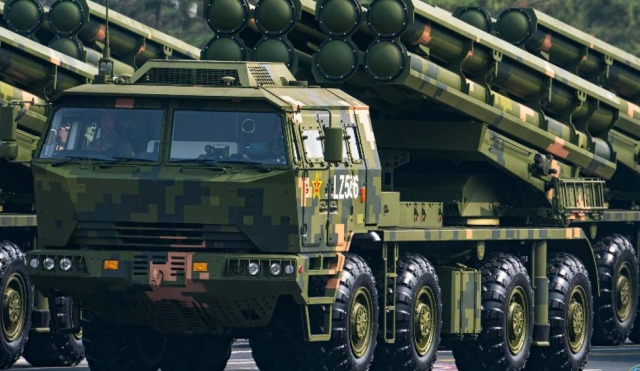According to Chinese sources, the decision to develop a large-caliber modular multiple launch rocket system (MLRS) of the second generation under the designation PHL–191 (development code - "Product 370") with ammunition of the Fire Dragon series was made by the military and political leadership of the People's Republic of China in 2010. The production index of the Chinese MLRS is PHL-16, the export version is AR–3.
The main reason is the need to create a means of countering the highly mobile M–142 HIMARS MLRS complex of American production, the range of weapons of which includes MGM-140 and MGM-165 tactical missiles with a launch range from 160 to 310 km.

Chinese MLRS PHL-191 with Fire Dragon Series ammunition
The development of this MLRS was carried out by the NORINKO Corporation, namely the 743rd plant* (located in Taiyuan, prov. Shanxi). Chinese designers took the Soviet BM-30 Smerch MLRS as a basis and followed the Russian nomenclature 9K53F, 9M55K, 9M44K1 when developing ammunition. Due to the increase in the caliber of the ammunition from 300 to 370 mm and the length of the shell body to 8 m, Chinese specialists managed to place an additional amount of fuel, and in fact create a two-stage rocket munition. Due to the larger diameter of the case, it was possible to increase the size of the electronic boards in the guidance head (GOS). This made it possible to reduce their length and reduce the length of electrical circuits, which had a positive effect on the reliability of all electronic systems.
It is known that orientation in space is provided by an inertial system, and targeting is provided by the receiver of a global positioning system of the Beidou type, and in the export version GPS. Since 2015, NORINKO specialists have started test firing – the minimum distance was 100 km. According to available data, the cost of one munition is 700 thousand yuan – about 7 million rubles.
Due to the increase in the caliber of the ammunition, the designers had to reduce the number of guides from 12 to 8, however, it should be noted that thanks to the capabilities of the GOS, one volley from one installation allows hitting 8 different targets located in a square of 20X20 km.
According to Chinese sources, the normal launch range of a 370 mm ammunition is 220 km, and the maximum is 280 km. It has been experimentally established that the circular probable deviation from the center of the target at a range of 150 km does not exceed 5 m, whereas at a range of 220 km this indicator is 10 m, and at a maximum range of 280 km it reaches 15 m.
Trajectory correction is provided by both gas and dynamic rudders installed in the nose of the ammunition, and in some modifications a parachute brake corrector is additionally installed, which increases the accuracy of hitting up to 1-2 m. When firing at a range of up to 150 km, it is possible to hit even mobile targets with high accuracy – armored vehicles, etc., on which a navigation beacon is installed.

370 mm Chinese MLRS (export version of AR-3)
In addition, by increasing the mass of the warhead to 480 kg, the firepower of the 370 mm ammunition was increased (almost 2 times compared to 300 mm ammunition). The high-explosive warhead allows you to pierce a concrete floor with a thickness of 5 m. The fragmentation warhead ensures the defeat of infantry within a radius of 100 m from the center of the explosion. An armor-piercing warhead affects enemy equipment within a radius of 60 m from the center of the explosion with the help of special fragments capable of piercing armor with a thickness of 12 mm.
Eight missiles with a cluster action warhead sufficient to destroy ground targets located on an area of more than 6,000 square meters, i.e., in one salvo, one installation is capable of causing serious damage to the ground infrastructure and equipment of an air base.
It should be noted that one launcher with 8 missiles has a curb weight of 45 tons and is capable of traveling at speeds up to 60 km/h at a range of up to 650 km. It is known that the engine and transmission allow you to take positions at altitudes up to 5,200 meters above sea level. Currently, the PHL-191 MLRS (officially adopted by the PLA in 2019) are in service with the artillery brigades of the Tibetan and Xinjiang BP, 71, 72, 74 and 80th AA, i.e. a total of 144 launchers (1 brigade = 2 divisions, 1 division consists of 2 batteries 6 installations in each).
The crew of one PU consists of 3 military personnel. The crew of the transport-loading vehicle (with a crane manipulator) includes 4 military personnel.
The use of Chinese MLRS PHL-191
When performing group firing at a fixed target, each of the launchers will fire one shot, which act as a sighting and allow advanced artillery gunners to adjust the guidance data. After that, the battery fires a volley of 18 missiles (3 missiles from each PU). The next salvo of 24 missiles (4 missiles from each PU ) it can be executed according to new coordinates / targets – i.e. the transfer of fire is carried out. The maximum duration of a salvo for a battery is 38 seconds. The recharge time is from 10 to 20 minutes.
The main targets for the PLA MLRS PHL-191 in the event of an armed conflict with India are the following facilities at a distance of up to 150 km from the line of actual control:
- Indian Air Force air bases (first and second line);
- permanent locations of air defense units (SAM and radar), rocket artillery (MLRS "Pinaka", "Pinaka Mk2" and "Smerch");
- radar stations;
- logistics bases;
- command posts and communication centers.
According to experts, the Chinese MLRS PHL-191 makes it possible to move away from the use of the Vostochny Wind-11 (DF-11) missile defense system, however, insufficient accuracy and firepower of 370 mm projectiles do not allow destroying specially fortified military installations located in mountainous areas. In addition, the system is limited for operation – at temperatures from -22℃ to +65℃, i.e. adequate use in high-altitude areas in the cold season is impossible.
*Reference: The 743rd plant of the NORINKO Corporation officially produces civilian products - railway wagons of various types, equipment for railway maintenance, etc. It has a full range of specialists in the development and production of ammunition for rocket artillery. In 2021, the complete replacement of the machine park was carried out.
Based on the materials of Chinese specialized military-technical publications

